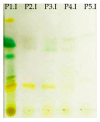An Integrated Biorefinery Process to Revalorize Marine Biomass from the Microalga Nannochloropsis gaditana Using Pressurized Green Solvents
- PMID: 40710488
- PMCID: PMC12298598
- DOI: 10.3390/md23070263
An Integrated Biorefinery Process to Revalorize Marine Biomass from the Microalga Nannochloropsis gaditana Using Pressurized Green Solvents
Abstract
Biorefinery is gaining attention as a promising approach to valorize natural resources and promote a circular bioeconomy. This study aimed to recover high-value molecules, such as xanthophylls and polar lipids with nutraceutical applications, through enzymatic pretreatment and sequential pressurized liquid extraction (PLEseq), by reusing the residual biomass of Nannochloropsis gaditana after each processing step. Remarkably, pure glycolipids (102.95 ± 1.10 mg g-1 dry weight) were obtained immediately after enzymatic pretreatment, facilitating their easy recovery. Furthermore, two alternative sequential extraction processes were successfully developed, using ethanol and water as green solvents at varying temperatures and in different orders. The most effective PLEseq conditions yielded up to 48 mg mL-1 of carbohydrates using water at 50 °C, and up to 44 mg mL-1 of proteins via subcritical water extraction at 100 °C, prior to conventional lipid extraction with ethanol to produce various concentrated extracts. In the inverted PLEseq process-starting with ethanol extraction followed by successive water washes-isolated and purified fractions of lutein and astaxanthin were obtained, contributing to the complete depletion of the residual biomass. Overall, the development of an integrated and sequential biorefinery protocol that enables the extraction of multiple high-value compounds holds significant potential for application in the food industry.
Keywords: Nannochloropsis gaditana; biorefinery; byproducts; carotenoids; microalgae; pressurized liquid extraction (PLE).
Conflict of interest statement
The authors declare no conflicts of interest.
Figures






Similar articles
-
Biobased Solvents for Pressurized Liquid Extraction of Nannochloropsis gaditana Omega-3 Lipids.Mar Drugs. 2021 Feb 12;19(2):107. doi: 10.3390/md19020107. Mar Drugs. 2021. PMID: 33673060 Free PMC article.
-
Sequential Extraction of Bioactive Saponins from Cucumaria frondosa Viscera: Supercritical CO2-Ethanol Synergy for Enhanced Yields and Antioxidant Performance.Mar Drugs. 2025 Jun 28;23(7):272. doi: 10.3390/md23070272. Mar Drugs. 2025. PMID: 40710497 Free PMC article.
-
Green sample preparation for anthocyanin extraction from purple corn: analytical evaluation of pressurized liquid and ultrasound-assisted extraction using sustainable solvents.Anal Bioanal Chem. 2025 Jul;417(18):4025-4037. doi: 10.1007/s00216-025-05951-8. Epub 2025 Jun 11. Anal Bioanal Chem. 2025. PMID: 40500349 Free PMC article.
-
The Black Book of Psychotropic Dosing and Monitoring.Psychopharmacol Bull. 2024 Jul 8;54(3):8-59. Psychopharmacol Bull. 2024. PMID: 38993656 Free PMC article. Review.
-
The experience of adults who choose watchful waiting or active surveillance as an approach to medical treatment: a qualitative systematic review.JBI Database System Rev Implement Rep. 2016 Feb;14(2):174-255. doi: 10.11124/jbisrir-2016-2270. JBI Database System Rev Implement Rep. 2016. PMID: 27536798
References
-
- Jacob-Lopes E., Maroneze M.M., Deprá M.C., Sartori R.B., Dias R.R., Zepka L.Q. Bioactive food compounds from microalgae: An innovative framework on industrial biorefineries. Curr. Opin. Food Sci. 2019;25:1–7. doi: 10.1016/j.cofs.2018.12.003. - DOI
-
- Mansour E.A., El-Enin S.A.A., Hamouda A.S., Mahmoud H.M. Efficacy of extraction techniques and solvent polarity on lipid recovery from domestic wastewater microalgae. Environ. Nanotechnol. Monit. Manag. 2019;12:100271. doi: 10.1016/j.enmm.2019.100271. - DOI
-
- di Visconte G.S., Spicer A., Chuck C.J., Allen M.J. The Microalgae Biorefinery: A Perspective on the Current Status and Future Opportunities Using Genetic Modification. Appl. Sci. 2019;9:4793. doi: 10.3390/app9224793. - DOI
-
- Vasistha S., Khanra A., Clifford M., Rai M.P. Current advances in microalgae harvesting and lipid extraction processes for improved biodiesel production: A review. Renew. Sustain. Energy Rev. 2021;137:110498. doi: 10.1016/j.rser.2020.110498. - DOI
MeSH terms
Substances
LinkOut - more resources
Full Text Sources

